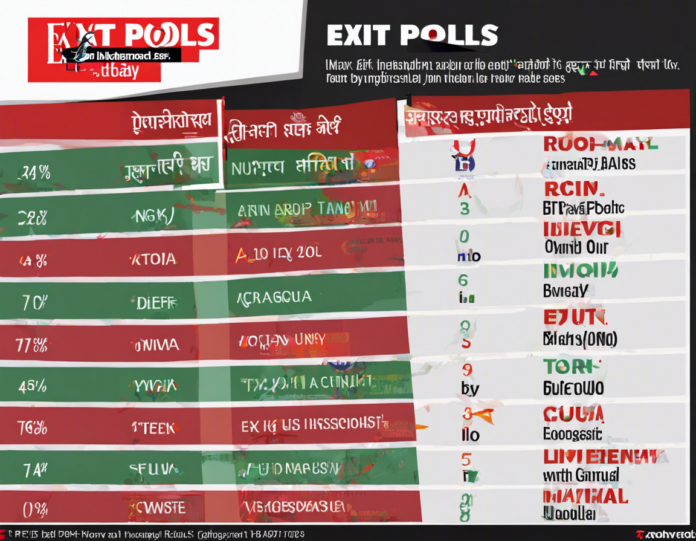Exit polls have become an integral part of the Indian political landscape, providing valuable insights into voter behavior and predicting election outcomes. In the era of instantaneous information dissemination, exit polls offer a snapshot of voter sentiment immediately after they cast their votes. For political parties, media houses, and the general public, these predictions are a crucial element in understanding the electoral dynamics and shaping post-election strategies.
Understanding Exit Polls
Exit polls are surveys conducted with voters immediately after they have cast their votes, typically outside the polling station. The aim is to capture voter preferences, trends, and potential outcomes of an election. The methodology involves interviewing a sample of voters to gauge which candidate or party they have voted for. The data collected is then analyzed to predict the final election results.
Importance of Exit Polls
1. Early Indication of Results:
Exit polls provide an early indication of election results, giving stakeholders a glimpse of potential outcomes before official results are declared. This information is crucial for political parties to assess their performance and plan their future strategies.
2. Voter Behavior Analysis:
Exit polls help in analyzing voter behavior, trends, and preferences. Understanding why voters made certain choices can provide valuable insights for political parties for future elections.
3. Media Coverage:
Exit polls generate significant media coverage and public interest. They keep the public engaged in the election process and contribute to a vibrant democratic discourse.
Methodological Challenges
1. Sample Size:
The accuracy of exit polls depends on the size and representativeness of the sample. A small or biased sample can lead to inaccurate predictions.
2. Margin of Error:
Exit polls often come with a margin of error, which means that the actual results may vary within a certain range. It is essential to interpret the results with this margin in mind.
3. Timing:
Exit polls are conducted immediately after voting, and voter preferences can change rapidly. A last-minute surge or decline in support for a candidate may not be captured accurately.
Trends and Analysis
1. State-wise Predictions:
Exit polls provide insights into the preferences of different states and regions. Understanding these regional variations is crucial for political parties to tailor their strategies accordingly.
2. Swing Factors:
Exit polls analyze swing factors such as demographic shifts, caste equations, and economic factors that influence voter behavior. Identifying these factors helps in understanding the dynamics of elections.
3. Coalition Building:
Exit polls can predict the potential outcome of coalition politics and help parties in forming pre-poll alliances based on projected results.
Impact on Financial Markets
1. Market Sentiment:
Exit polls can influence market sentiment, especially for sectors sensitive to political changes. Investors often react to exit poll results, which can lead to fluctuations in stock prices.
2. Policy Expectations:
The predicted election outcome from exit polls can shape market expectations regarding policy changes and economic reforms. This anticipation can impact investment decisions and market trends.
3. Currency Fluctuations:
Exit poll results can also impact currency markets, leading to fluctuations in exchange rates based on the perceived political stability or uncertainty.
Role of Exit Polls in Democratic Process
Exit polls play a significant role in the democratic process by promoting transparency, accountability, and informed decision-making. They create a more engaged electorate by providing real-time feedback on voter preferences and expectations. However, it is crucial to interpret exit polls with caution, considering their limitations and the dynamic nature of electoral politics.
Frequently Asked Questions (FAQs)
1. Are exit polls always accurate in predicting election outcomes?
Exit polls provide a directional trend rather than an exact prediction. While they offer insights into voter behavior, unforeseen factors and last-minute shifts can impact the final results.
2. How do exit polls impact voter behavior?
Exit polls can influence undecided voters or those leaning towards a particular candidate to consolidate their choices strategically. Voters may also use exit poll results to gauge the overall momentum of a candidate or party.
3. Do exit polls have any legal implications in India?
Exit polls are regulated by the Election Commission of India, and there are guidelines to prevent the dissemination of exit poll results before voting ends in all phases of an election. Violations can lead to legal action.
4. Do exit polls reflect the entire electorate’s opinion accurately?
Exit polls are based on a sample of voters and may not always represent the entire electorate’s diverse views. It is essential to consider demographic variations and regional factors when interpreting exit poll results.
5. How do parties use exit poll data for post-election strategies?
Political parties analyze exit poll data to assess their performance, identify strengths and weaknesses, and strategize for future elections. They may also use this data to negotiate alliances or plan communication strategies post-election.
6. What are the ethical considerations in conducting exit polls?
Conducting exit polls ethically involves ensuring the confidentiality and voluntary participation of voters, maintaining impartiality in data collection and analysis, and disseminating results responsibly to avoid undue influence on the electoral process.
7. Can exit polls impact voter turnout on election day?
There is a debate on whether the publication of exit poll results influences voter turnout. Some argue that early predictions may demotivate supporters of trailing candidates, while others believe that heightened public interest due to exit polls can increase voter participation.
8. How do exit polls differ from opinion polls?
Exit polls are conducted after voters have cast their votes, while opinion polls gauge voter preferences before the actual election. Exit polls provide a more immediate and direct reflection of voting patterns, whereas opinion polls offer a broader perspective over a period.
9. Do exit polls have any influence on coalition politics in India?
Exit poll predictions often shape the narrative around potential coalition scenarios. Parties may use these projections to assess post-election alliance options and negotiate power-sharing arrangements based on the expected results.
10. In what ways can the accuracy of exit polls be improved for more reliable predictions?
Enhancing the sample size, ensuring demographic diversity in the sample, considering margin of error, and accounting for dynamic factors in voter behavior can improve the accuracy of exit polls. Employing robust methodologies and conducting thorough post-poll analysis can also enhance predictive capabilities.
Exit polls continue to be a crucial tool for political analysis, generating insights into voter behavior and shaping electoral narratives. However, it is essential to approach them with a critical eye, considering their limitations and the fluid nature of electoral dynamics. As India’s vibrant democracy evolves, so too will the role and impact of exit polls in shaping its political landscape.

